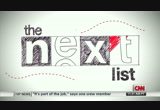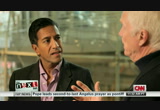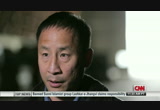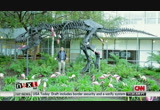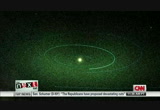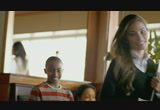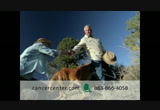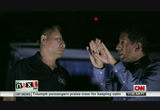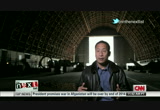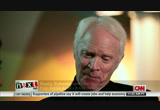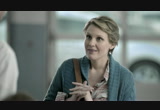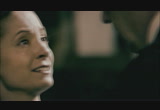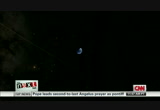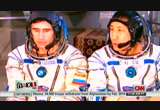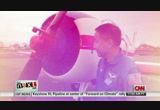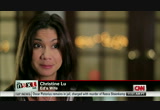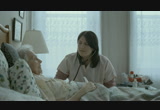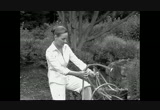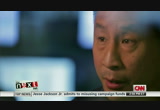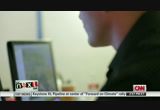tv The Next List CNN February 17, 2013 11:30am-12:00pm PST
11:30 am
below 60 really. >> exactly. i always complain about that but now at least i have winter clothes. >> you're all set. >> i'm all set. >> i heard from somebody i spoke with at "sports illustrated" just yesterday he told me that you were the model of professional, you didn't complain about one thing. was he being nice? you had to complain a little bit, no? >> you know, i think that i was frozen, and i couldn't talk. now i can complain. >> well the reports were you actually did get frost bite and there were some health issues you had to be concerned about so it was kind of dangerous really if you step back from it. >> it was, and you know, my body was so worn down from trying to keep me warm and my heart was always facing so luckily i got cover and it was worth it. >> how long were you there for? >> we were shooting there six days but on the boat for ten. >> you weren't staying in an igloo, nothing like that. >> no. >> a warm, comfortable boat. >> every time i went back to the
11:31 am
boat, the expedition leaders would be like think of the explorers back in the day, they didn't have a nice cruise ship to come back to. i'm like i'm not an explore he were, i'm a bikini model. >> how giggly were the expedition leaders to be on the boat with a supermodel taking fashion photos? they have to have been red in the face. >> i think they thought we were crazy. >> having done this a second time put on the cover, my understand something they don't know that until they see the photographs, that's when they decide who is going on the cover. >> yes. >> now as a repeat covergirl, if you don't mind me using that expression, cover model, cheryl degrees, tyra banks. >> those are the women i looked up to and saw them in the magazines and now i'm with their group so it's amazing. >> pretty cool. >> deb, i think it is clear that
11:32 am
kate upton has joined the ranks of some of the greatest supermodels of all-time. >> absolutely. thanks, a.j. of course you can watch a.j. on "showbiz tonight" monday through friday 11:00 p.m. on hln. > i'll be back at 4:00 p.m. eastern including president obama's wish list. he's laid it out but will he get what he wants? first dr. sanjay gupta and astronaut ed lu go hunting for dangerous ast noits that could potentially destroy our earth. "the next list" starts right now. >>
11:36 am
we know this because we have the fossil record of this. look at this rock if you go anywhere around the world and dig down to the right level you'll find a layer of dark rock like that, called the kt boundary. it's the same layer anywhere around the earth. below this there are fossils of dinosaurs. nasa discovered this and they have funded over the last 20 years a search for the very largeest of asteroids. >> so they did a good job of tracking the very big but these smaller ones that could cause a huge problem what's happening with them? >> not much. they've never been able to fund a search for smaller asteroids, ones that might only wipe out a continent or collapse the world economy for a century. something we're not looking for, to me that seems crazy.
11:37 am
so this is what we are trying to protect. >> this is the view you have when you go up? >> it's a little higher up than i was. if you look at the green line that's the earth. this is the orbit of every single asteroid known in our solar system. >> swarming around. >> it's a busy place. the outer bow nut is the asteroid belt. these are near earth asteroids and a lot of them are whizzing past the earth. using our telescopes on the ground we've only surveys 1% of the volume of space. the real solar times has 100 times more asteroids than you see now. these are the 10,000 known real asteroids. the real solar system looks like this, 1 million near asteroids larger than the one which hit in 1908. that means we found 1%. the other 99% are currently out
11:38 am
there but unknown. let's look at asteroids five times bigger than all the bombs used in world war ii and there's a 1% chance that's going to happen in any person's lifetime. that's also your chance of dying in a car accident, 1%. >> wow. >> i'll ask you, do you wear a seatbelt? >> i do. >> why? it's only 1% chance in your lifetime you're going to get killed by a car. why would you do that? it's not big odds, right? >> it's not but i do everything i can to try and protect myself. >> so who is protecting the earth? >> up next, meet the sentinel, ed lu's astonishing telescope that just might save the world.
11:39 am
(music throughout) why turbo? trust us. it's just better to be in front. the sonata turbo. from hyundai. there's nothing like our grilled lobster and lobster tacos. the bar harbor bake is really worth trying. [ male announcer ] get more during red lobster's lobsterfest. with the year's largest selection of mouth-watering lobster entrees. like our delicious lobster lover's dream, featuring two kinds of succulent lobster tails. or our savory, new grilled maine lobster and lobster tacos.
11:40 am
11:41 am
the plan of the b612 foundation is going to orbit the sun. this is the sentinel space telescope. >> that's basically the size of it there? >> yeah, the real one is about the size of say a delivery truck, so it's about 23, 24 feet tall, and about 2,600 pounds. >> it's got its back to the moon? >> back to the sun. >> back to the sun and constantly surveying everything around it. >> exactly.
11:42 am
as you know it's hard to look with a telescope in the direction of the sun. the nighttime sky is in the opposite direction of the sun. the challenging thing about the sentinel mission is that it's going to be quite far away from earth. it will orbit the sun so that means its distance will vary from the earth but it will range between 30 million miles at its closest to 170 million miles away from earth at its furthest. that's about 500,000 times further from earth than the hubble space telescope. we have challenges but we can send probes to mars, we can do this too. >> we can see anything that might possibly be a threat to the earth? >> that is exactly right. this is what the sky looks like in infrared which is basically heat. asteroids are very, very dark, they're almost black and therefore they glow in infrared because they're warmed by the sun, and so if you look in
11:43 am
infrared, those are the aster d asteroi asteroids. over a six and a half year period it will scan earth's orbit multiple times and map all the asteroids across the earth's orbit. it's going to track about half a million asteroids so each month it's going to discover about 10,000 asteroids. >> each month? >> each month, yes, which is more than all other telescopes throughout history have combined to discover, so it will do that every month. one of the innovative things i think we're doing is that we are funding this privately. we are a a non-profit foundation funded by private donations. that does not mean that we don't have some government involvement because nasa is for instance a partner of us. nasa provides the communications and tracking of the spacecraft because they have those facilities already built and in return, we will make all the data publicly available. so our contract with the world as we find and discover these
11:44 am
asteroids, all that data is open. >> we may be opening a frontier for a new way of doing these deep space missions and nobody's ever done one with private investment, with philanthropy. >> if you look at the cost of a spacecraft that can find the asteroids? >> what are we talking here? >> a few hundred million dollars. universities raise it all the time to build a new chemistry building or art museums raise that all the time to build a new wing. that's the kind of scale you're talking about. >> how's it going? that's what you're doing now, you're trying to raise that money. >> it's going really well. we announced publicly just this last year and we've raised quite a bit of funds and we've been moving. >> ed lu is at the helm of this. >> right. >> is he the right guy? >> absolutely. ed is terrific. he's a great salesman and now and you got to recognize this is not just a technical issue.
11:45 am
there's a whole seat change going on in space now where private enterprise is doing a lot of really incredibly bold things in space. >> i feel like we've been offered the chance to positively change the course of humanity, and how can you turn that down? i mean, if you are lucky once in your lifetime, will you ever get a chance like that? and so we feel very blessed that we are here at this right time when we can do this. >> what happens if the telescope finds a massive asteroid headed toward earth? wait until you see what he's invented, that's next. [ female announcer ] what if the next big thing, isn't a thing at all?
11:46 am
it's lots of things. all waking up. connecting to the global phenomenon we call the internet of everything. ♪ it's going to be amazing. and exciting. and maybe, most remarkably, not that far away. we're going to wake the world up. and watch, with eyes wide, as it gets to work. cisco. tomorrow starts here.
11:48 am
so how do you deflect an asteroid? >> the earth is a moving target. all you do is get the asteroid, move it early or a little bit late. when i was with nasa i invented with another astronaut stan love one of the means of deflecting asteroids, called a gravity track and all it is, a small spacecraft that hovers near an asteroid and if you hover near something as long as your jets aren't pointed at it you can slightly tow an asteroid a very, very tiny amount but that's all you really need over a period of months to change an asteroid's trajectory enough so that you can cause it to miss the earth. i learned a lot at nasa. it has helped me as we set up
11:49 am
the b612 foundation. >> three, two, one, we have booster ignition and liftoff of the space shuttle "atlantis." >> what was that first mission like? >> it was awesome. you always remember that more than the other ones even though the other ones were great. >> we'd like to say it's amazing, i can't believe we're actually here. >> the space shuttle mission "atlantis" in 1997, we went to the mier space station. >> hi mom, hi dad. >> you could talk to ed probably for hours and never know that he spent six months on the international space station. there have been about 525 astronauts and very, very few have ever spent that much time on the space station, so he's part of a very select group. >> i think the highlight of my career at nasa was actually a time of crisis at nasa. >> safety is on everyone's mind
11:50 am
since the "columbia" shuttle disaster. >> 2003 we lost the shuttle "columbia" so seven good friends died that morning. for the foreseeable future all space shuttle flights were grounded. the only way into space at the time was the soyuz. no american was trained to fly, we were left what do we do? friday afternoon the chief astronaut said to me, we're going to give it a try, put two people on the space station and it's you. so sunday i was on an airplane. the normal training flow for a cosmonaut flying as the co-pilot of a soyuz is typically a year or so, and we had nine weeks so the only way to do that was for me to go morning 'til night, seven days a week. we fell asleep on the launch pad, that's how tired we were. >> obviously the first few weeks are difficult and i think we're ready. >> myself and a russian cos cosmonaut named yurie
11:51 am
melenchenkov spent six months on the space station. i remember specifically a couple hours after launch where we were now in orbit in the little capsule and i remember thinking to myself looking out the window thinking how crazy is this, cry knees-march kid from upstate new york, flying a russian spacecraft, it's crazy i ended up in that spot. i was a nerdy kid. i grew up in a small town called webster new york, which is outside of rochester, new york. iless always interested in science, my dad was an engineer. i loved anything that flew and anything that had to do with the skies. i loved airplanes more than just about anything except my family and depends on whether or not my family is present or not what i say. this is the airplane my wife refers to as the mistress, and it is the airplane i get to fly on weekends. this is an old flight suit from
11:52 am
my sts-106 days, that's our second flight, that's our patch. my first interest was with the space program, watching the astronauts land on the moon and one of the great measures i have now is that i'm friends with many of these guys. in fact, with the b612 foundation, i cofounded the foundation with rusty schweikert who has been a mentor to me and he was the first pilot of the lunar module. >> ed is a big thinker and because of his work ethic and the education that he's gotten, the way he thinks, he literally has the opportunity to act on that big stage. >> he's just a very humble person and he doesn't feel a need to prove that he's better or whatever to anybody. he's just very comfortable about who he is and i think that's why he's able to do all these things that he does. he's not trying to prove to anybody that he's anybody. he's just trying to be happy and
11:53 am
fulfill what his dreams are. >> you have a family. your parents obviously, but also your wife and kids. were you on any missions after you got married? >> no, on my last mission i was engaged but not yet married. >> would you still go up, with the family or are you worried about safety? >> if i had a chance to go up again i think i might like to do that. obviously this would be a family decision now. >> mrs. lu is listening. what is she thinking? >> she does have a say in this. we say in our family we have an almost equal partnership where she gets 51% of the voting bloc. >> i'm familiar with that. >> yes. >> ed lu isn't just about asteroids. he's also exploring the deep sea with robots unlike anything you've ever seen before. that's next. t rate, administering her medication, and just making her comfortable. one night britta told me about a tradition in denmark, "when a person dies," she said, "someone must open the window so the soul can depart."
11:54 am
11:56 am
11:57 am
on exploration. everything from a revolutionary new way to create 3-d maps to autonomous ocean robots. >> we're here at liquid robotics today and we build ocean-going robots that swim on their own and take data all over the oceans in every ocean around the world. my real job here is as an instigator. i'm chief of innovative applications here at liquid robots. these things are just like little satellites. they transmit data up through satellites, they swim on their own, powered by waves. you can change instruments on this, put whatever instruments you want. for instance you can measure water temperature, you can get up to the minute winds, waves, oil in the water, if you're looking for oil leaks, whatever you want to put inside it. i think this is pretty cool because it is changing the way we measure conditions on the oceans. right now, if you want to measure the amount of carbon dioxide in the water in some location you have a couple choices, you can measure it from space or you can send a ship or place a buoy there, all of that
11:58 am
is hugely expensive. the other way you might do that is deploy these cheap fleets of robots. right behind me is the control center where we steer and control our fleets of robots around the world. it's a lot like mission control in houston. this is a huge similar between ocean and space, vast areas, relatively unexplored and they're environmentally tough so the way you go about exploring them is actually kind of similar. >> i think he's an adventurer, a futurist, an explorer, not only of space, but of the horizon of technology as well. >> right now we're at the offices of hover, which is a small startup here in los altos in silicon valley. my role here is to stay out of their way while they're working.
11:59 am
this company makes three-dimensional maps from overhead images, street level images, whatever images you can get. we can turn those images into three-dimensional models that we can see and update so they are constantly updated using all the symmetry that comes in. the company was started by some nayy s.e.a.l.s and marine intelligence officer who was in iraq and basically what they did was set out to give our troops on the front lines a tool that allows them to understand what they're about to get into. >> whether it's military or other sorts of tactical environments like law enforcement they're trying to get a sense of what that place will look like before they get there. >> this is a.j. altman who is our founder here at hover. i'm going to just ask a.j. to cross the street without getting killed and take my picture in front of the building here. on three, wave. so we just took that picture
110 Views
Uploaded by TV Archive on

 Live Music Archive
Live Music Archive Librivox Free Audio
Librivox Free Audio Metropolitan Museum
Metropolitan Museum Cleveland Museum of Art
Cleveland Museum of Art Internet Arcade
Internet Arcade Console Living Room
Console Living Room Books to Borrow
Books to Borrow Open Library
Open Library TV News
TV News Understanding 9/11
Understanding 9/11


